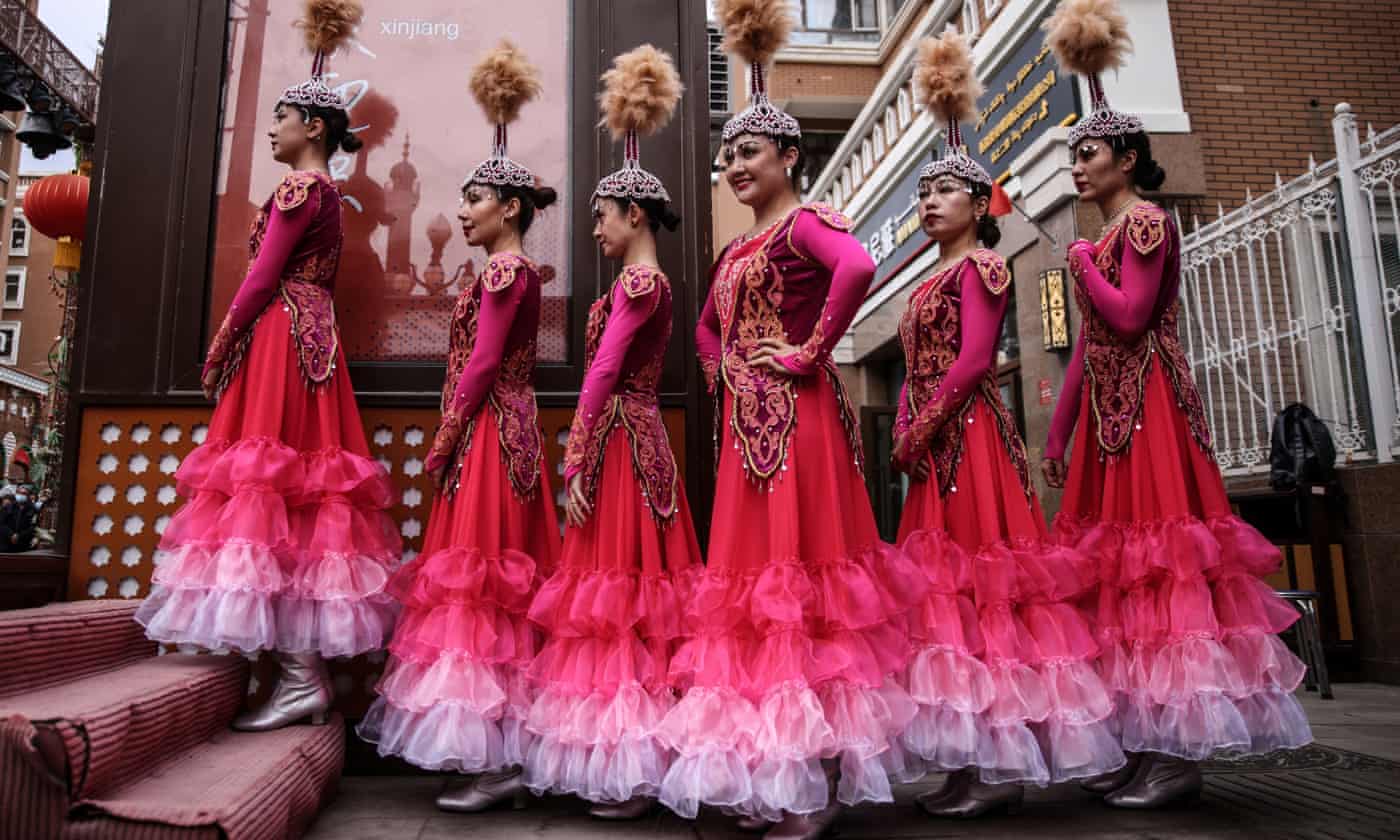Exoticised spectacle … dancers wait to perform at the International Grand Bazaar in Urumchi Photograph: Wu Hong/EPA
Ancient shrines, oral folklore and hip-hop cyphers are all part of a rich artistic heritage being ‘hollowed out’ in Xinjiang, say Uyghur exiles and scholars
While the ruling has no legal standing, the aim is to highlight the treatment of Uyghurs, Kazakhs and other Turkic Muslims in north-west China. Rachel Harris, a British ethnomusicologist and Uyghur specialist, has described the state’s strategy as an attempt “to hollow out a whole culture and terrorise a whole people”.
Much has been written about the destruction of the Uyghur heritage: of the mosques and shrines, old city centres and traditional burial grounds. In order to understand what intangible heritage is being lost – what is being quite literally silenced – amid that bulldozing, I interviewed 10 specialists, including both Uyghurs in exile and international scholars with extensive experience on the ground.
In Muslim soundscapes the world over, the adhan is the most salient of notes. Calls to prayer, though, have long been absent from urban Uyghur life and now, even private devotion has reportedly been muted. Through a policy called “becoming family”, government officials are sent to stay in Uyghur homes so as to root out anything deemed illegal (owning Uyghur-language books, wearing traditional clothing).
Academics and pop culture figures have been disappeared en masse, among the estimated 1.5 million people detained in “re-education” camps, with children as young as one separated from parents and put in Mandarin-language state orphanages. Schools have been banned from teaching Uyghur and no Uyghur-language books have reportedly been published in China since 2017. “People used to bury their books,” the American photographer Lisa Ross tells me, “but now they’re afraid to even do that.” In a bid to cut off an indigenous culture at the root, the Uyghurs language, sound and music are being excised from the public and private spheres.
When Darren Byler, an anthropologist from Colorado, lived in Urumchi in the early 2010s, student house parties – which were held most weekends – always involved everyone making music together. Friends would bring instruments. People were always singing. “Everyone is a poet,” he says. “People think poetically.” As a Turkic language, Uyghur is agglutinative, explains Byler, so they would often have fun adding rhyming suffixes to the ends of their words. This verbal dexterity defines ancient storytelling forms like the epic dastan – spoken tales – that pilgrims would hear at festivals in the Taklamakan desert. It also birthed a vibrant local hip-hop scene in Urumchi that Byler came to know.
Now, all gatherings – prayer in public, mazar (shrine) festivals, traditional meshrep parties, hip-hop cyphers, even football matches – have been outlawed.
Destroying a built structure makes visible the dismantlement of more abstract cultural ones. The mazar, which are dotted throughout the desert as well as in towns and cities, are a case in point. Before they were razed, these shrines were closed. This resulted in the rural community structures and ancient cultural practices that activated them being shut down, too.
Mazar festivals would be held every Thursday at certain periods of the year: throughout the mulberry season at Imam Asim shrine, say, or during grape season at Kok Marim shrine. Starting in the early 2000s, Ross documented the mazar extensively. She photographed mountains of hand-made prayer flags and devotional objects affixed to wooden poles that day pilgrims – in their tens of thousands – would bring each year.
A Uyghur scholar, who wishes to remain anonymous, describes what it felt like to be there. At Imam Asim, there were tandoori pots the size of small rooms, in which a gaggle of men with shovels would stir a stew called sheeylang. Pilgrims would add in whatever they could (a sheep they’d brought to slaughter on site; a single grain of rice).
And the sound? “It’s like a wedding and a funeral happening at the same time,” the scholar tells me. There would be epic dastan sessions, stories reminding pilgrims of why they came and where they come from. There would be dancing, drumming, chanting, weeping, praying. “It is something you won’t hear anywhere else.”
When Harris and Rahile Dawut – a Uyghur folklore expert who disappeared four years ago and whose imprisonment has since been confirmed – visited the largest and oldest shrine, Ordam Padishah, in 1995, they wrote that state opposition to the shrines lay arguably in the sphere of aesthetics – the sights and sounds – rather than in response to any political threat.
The site was closed to the public in 1997 and satellite imagery now shows it has been entirely razed. Imam Asim, too. The Australian Strategic Policy Institute puts the number of mosques, mazar and cemeteries in Xinjiang that have been damaged or destroyed since 2017 at up to 80%.
Elsewhere, a re-engineered version of living Uyghur culture has been instituted. This process is best illustrated by what has happened to meshrep. In this uniquely Uyghur festive tradition, music and storytelling are used to transmit cultural or moral knowledge. But when China sought for meshrep to be included on Unesco’s intangible cultural heritage list in 2009, Harris, who was acting as official examiner, pushed back.
“I thought the only way for meshrep to be sustained would be by folkloric presentation,” she says. Unesco nonetheless granted China the heritage status it wanted and China promptly banned grassroots gatherings. Villages now have state-sanctioned meshrep centres with murals featuring slogans – “Everyone let’s dance”; “Welcome to our meshrep” – that drive home the notion of what is “healthy” (ie, acceptable) meshrep, and what isn’t. Religious lyrics are rewritten as revolutionary patriotism. Uyghurs are forced to attend.
Performers also have to take part in exoticised song-and-dance spectacles that cater to the growing national tourism industry. “You can see them on YouTube,” says Harris, “and I mean, they are amazing.” But, she says, these shows turn the Uyghur people into “empty vessels who sing and dance and smile for tourists, but have no rights to develop their own culture or religion.”
Last year, Mijit and Harris organised an online event billed as the first transcontinental Uyghur concert. Under the banner “Longing for Home”, musicians from across the globe played from the classical muqam repertoire for two hours. It brought Mijit to tears.
“It is really beautiful to hear this music,” she said. “Beautiful song, beautiful poetry. This is us, this is our voice, this is our culture.” Exile has always been a potent musical metaphor. But in the context of the Uyghur people’s plight, it is not imagery. It is an emergency.

